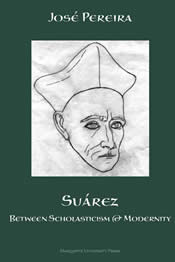52. Suárez. Between Scholasticism & Modernity, by José Pereira. ISBN-13: 978-087462-750-3 & ISBN-10: 0-87462-750-8. ©2007. 384 pages. Paperbound. Bibliography. Index. $37
Francisco Suárez (1548-1617) is one of the great anomalies in the history of thought: of one thinker functioning in two contrary roles, each reversing the other. The role of being, on the one hand, the consummator of one phase of philosophical speculation, the realist and Scholastic; and on the other, the initiator (though an unwitting one) of another phase, the idealist, modern and nihilist. This shift from realism to idealism was crucial in Western philosophy; it inaugurated an era of irrepressible, if chaotic, creativity.
On the one side, cosmos, the climax of a tradition of over a millennium, embodied in the most massive work of systematics in the history of speculation, the 21-million worded Suarezian synthesis; on the other, chaos, the rise of a plethora of systems, anti-systems and non-systems in a mad sequence of innovations and novelties, each appearing to cancel out the others, all seemingly hurtling toward the black holes of skepticism, anti-realism, relativism and nihilism itself. The anomaly is all the more striking because this conflagration was presumably kindled by the tremendous claim, but made by a small word, that objective truth can be known by ascertaining a subjective state of mind. The small word was notior, “better known”; its claim was that the intra-mental consciousness is “better known” to us than the extra-mental reality itself, and can serve to establish the latter’s truth.
José Pereira earned his doctorate at the University of Bombay 1n 1959 in Ancient Indian culture. Since then he held academic positions in Lisbon, London, Benares and New York: at Fordham University, where he was Professor of Theology, teaching History of Religions from 1970 to 2001. His publications deal with theology, philosophy and architectural history, and include Hindu Theology (Doubleday, 1976), Baroque India. The Neo-Roman Architecture of South Asia (New Delhi, 2000), and The Sacred Architecture of Islam (New Delhi, 2004). His one love has always been the Baroque period, which inspired The Mystical Theology of the Catholic Reformation. An Overview of Baroque Spirituality (AUP, 2006, co-authored with Robert Fastiggi).






